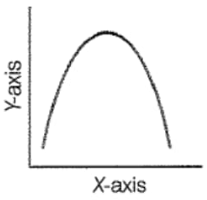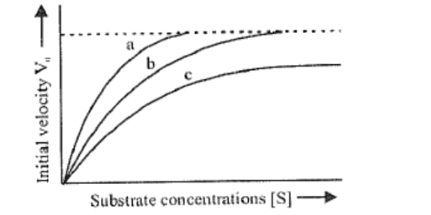Cellulose, the most important constituent of plant cell wall is made of
| 1. | Unbranched chain of glucose molecules linked by 1, 4-glycosidic bond |
| 2. | Branched chain of glucose molecules linked by 1, 4-glycosidic bond in straight chain and , 1, 6-glycosidic bond at the site of branching |
| 3. | Unbranched chain of glucose molecules linked by 1, 4-glycosidic bond |
| 4. | Branched chain of glucose molecules linked by 1, 6-glycosidic bond at the site of branching |
The major portion of the dry weight of plants comprises of
1. Carbon, nitrogen and sulphur
2. Carbon. nitrogen and oxygen
3. Nitrogen, phosphorous and potassium
4. Calcium, magnesium and sulphur
Genes are packaged into a bacterial chromosome by
1. Histones
2. Basic proteins
3. Acidic proteins
4. Actin
Km value is dependent upon
| 1. | Temperature |
| 2. | Substrate concentration |
| 3. | Enzyme concentration |
| 4. | All of the above |
The curve given below shows enzymatic activity with relation to three conditions (pH, temperature and substrate concentration).
What do the two axis (X and Y) represent?

X-axis Y-axis
1. Temperature activity - Enzyme
2. Substrate concentration activity - Enzymatic
3. Enzymatic activity - Temperature
4. Enzymatic activity - pH
About 98% of the mass of every living organism is composed of just six elements including carbon, hydrogen, nitrogen, oxygen and:
1. Phosphorous and sulphur
2. Sulphur and magnesium
3. Magnesium and sodium
4. Calcium and phosphorous
In non-competitive inhibition:
| 1. | the substrate and inhibitor cannot bind to the enzyme at the same time |
| 2. | the inhibitor binds only to the substrate enzyme complex |
| 3. | the inhibitor can bind to the enzyme at the same time as the enzyme's substrate |
| 4. | the binding of the inhibitor to the enzyme reduces its activity but does not affect the binding of substrate |
Which of the following elements is present in higher proportion [% weight of the total] in Earth's crust with respect to the average composition of a human body?
1. Carbon
2. Nitrogen
3. Sulfur
4. Magnesium
All the following are nucleosides except:
| 1. | Adenosine | 2. | Cytosine |
| 3. | Guanosine | 4. | Uridine |
At each step of its ascent, the DNA strand turns:
1. 3.4
2. 34
3. 3.6
4. 36
The substrate has to go through a much higher energy state or transition state in case of:
| 1. | Exothermic reactions only |
| 2. | Endothermic reactions only |
| 3. | Both exothermic and endothermic reactions |
| 4. | Neither exothermic nor endothermic reactions |
Locomotion is a very important feature in animals. Considering the frequent need for locomotion in animals, an animal would obtain the greatest benefit from storing its energy as:
1. proteins
2. minerals
3. carbohydrates
4. fats
Populations subsisting primarily on corn would likely to suffer from:
1. PEM
2. Pellagra
3. Bleeding disorders
4. Beri beri
The vitamin Niacin functions as a coenzyme in:
| 1. | Nucleoprotein synthesis |
| 2. | Hydrogen transport |
| 3. | Fatty acid synthesis |
| 4. | RBC production |
Based on the graph of enzyme-catalyzed reaction, which of the following could be used to increase the reaction rate beyond point C?

| 1. | increase the amount of substrate |
| 2. | add more water |
| 3. | increase the temperature |
| 4. | decrease enzyme concentration |
Which of the following biomolecules is common to respiration-mediated breakdown of fats, carbohydrates and proteins?
1. Glucose -6-phosphate
2. Fructose 1, 6-bisphosphate
3. Pyruvic acid
4. Acetyl Co-A
Which one of the following statement is incorrect?
| 1. | A competitive inhibitor reacts reversibly with the enzyme to form an enzyme-inhibitor. |
| 2. | In competitive inhibitor the inhibitor molecule is not chemically changed by the enzyme. |
| 3. | The competitive inhibitor does not affect the rate of breakdown of the enzyme-substrate complex. |
| 4. | The presence of the competitive inhibitor decreases the km of the enzyme for the substrate. |
Select the option which is not correct with respect to enzyme action.
| 1. | Substrate binds with enzyme as its active site. |
| 2. | Addition of lot of succinate does not reverse the inhibition of succinic dehydrogenase by malonate. |
| 3. | A non-competitive inhibitor binds the enzyme at a site distinct from that which binds the substrate. |
| 4. | Malonate is a competitive inhibitor of succinic dehydrogenase. |
The essential chemical components of many coenzymes are
1. Proteins
2. Nucleic acids
3. Carbohydrates
4. Vitamins
Phosphodiester bond is present in
| 1. | ATP | 2. | ADP |
| 3. | cAMP | 4. | none of these |
In which one of the following sets of three items each belong to the category mentioned against them?
| 1. | Lysine, glycine, thiamine - amino acids |
| 2. | Myosin, oxytocin and gastrin - hormones |
| 3. | Rennin, helicase and hyaluronidase - enzymes |
| 4. | Optic nerve, oculomotor, vagus - sensory nerves |
The figure given below shows three velocity substrate concentration curves for an enzyme reaction. What do the curves a, b and c depict respectively?

1. a - normal enzyme reaction
b - competitive inhibition
c - non-competitive inhibition
2. a - enzyme with an allosteric modulator added
b - normal enzyme activity
c - competitive inhibition
3. a - enzyme with an allosteric stimulator
b - competitive inhibition reaction
c - normal enzyme reaction
4. a - normal enzyme reaction
b - non-competitive inhibitor added
c - allosteric inhibitor added
Which of the following contain -1, 4 linkage?
1. Maltose
2. Sucrose
3. Lactose
4. Fructose
Jute fibres deteriorate quickly because
| 1. | cellulose content is high |
| 2. | lignin content is high |
| 3. | cellulose content is low |
| 4. | lignin content is low |
Enzyme often has additional parts in their structure that are made up of molecules other than proteins. When this additional chemical part is an organic molecule, it is called
1. cofactor
2. coenzyme
3. substrates
4. Both (1) and (2)
The quaternary structure of a protein:
| 1. | Consists of 4 subunits - hence the name quaternary |
| 2. | Is unrelated to the function of the protein |
| 3. | Both (1) and (2) |
| 4. | Depends on the 1 structure of subunits |
Which one is heteropolymer?
| 1. | Chitin |
| 2. | Peptidoglycan |
| 3. | Both (1) and (2) |
| 4. | Inulin |
Which of the following is true about chitin
| 1. | It is a monomer of N-acetyl glucosamine |
| 2. | It is a heteropolymer of NAG |
| 3. | It is the most abundant organic compound in Nature |
| 4. | All of the above |
Which of the following is not true about starch?
| 1. | It's a branched polymer |
| 2. | Amylose and amylopectin are its two components |
| 3. | it's a polymer of , D Glucose |
| 4. | It is the most abundant organic compound in Nature. |
How many of the following bond is present in tertiary structure of protein
Hydrophobic interaction, Hydrogen bonding, Di-sulphide bond, Ionic bond, peptide bond
1. 5
2. 4
3. 3
4. 2
Which of the following is the strongest bond in protein?
1. peptide bond
2. Hydrogen bonding
3. Di-sulphide bond
4. Ionic bond
Which of the following proteins exist in their quaternary structure
| 1. | Myoglobin | 2. | Haemoglobin |
| 3. | Globulin | 4. | Both 1 and 2 |
How many heme groups are present in Myoglobin
1. 2
2. 1
3. 4
4. 3
How many groups of the methane can be substituted to form an amino acid Glycine?
1. 4
2. 3
3. 2
4. 1
How many types of amino acids are there?
1. 20
2. more than 20
3. less than 20
4. Both 1 and 3
The number of Carboxyl groups present in the Aspartic acid is
1. 1
2. 2
3. 3
4. 4
How many basic amino acids are there which takes part in protein synthesis?
1. 5
2. 3
3. 2
4. 15
How many ionisable groups are present in Aspartic acid?
1. 4
2. 3
3. 2
4. 1
Which of the amino acid contains hydroxyl group?
1. Serine
2. Threonine
3. Phenylalanine
4. Both (1) and (2)
Out of 20 proteinaceous amino acids how many of them are laevorotatory (l-form).
1. All 20
2. 10
3. 19
4. 18
Which of the following is a standard but non-essential amino acid?
1. Methionine
2. Tyrosine
3. Ornithine
4. Isoleucine
Which of the following is not true about Arachidonic acid?
1. It is a saturated fatty acid
2. It has 20 Carbons excluding Carboxyl carbon
3. It has no double and triple bonds between carbon atoms
4. All of these
Which of the following is true about wax?
1. Monoglycerides
2. Diglycerides
3. Triglycerides
4. All of these
Which of the following is true about Lecithin?
1. It is made of 2 fatty acids + glycerol + Phosphoric acid + Choline
2. It is made of 2 fatty acids + glycerol + Choline
3. It is made of 3 fatty acids + glycerol + Phosphoric acid + Choline
4. It is made of 2 fatty acids + glycerol + Phosphoric acid + Serine
Incorrect about lipid tails is
1. Hydrophobic in nature
2. Hydrophilic in nature
3. Water insoluble
4. Non-polar
When chemical analysis of living tissue was done using trichloroacetic acid, then the filtrate formed was
1. acid insoluble fraction
2. acid soluble fraction
3. retentate
4. Both (1) and (3)
When chemical analysis of living tissue was done using trichloroacetic acid, then inorganic compounds were found to be present in
1. Acid soluble pool
2. Acid insoluble pool
3. Both (1) and (2)
4. Cannot be determined
All living organisms never attain
1. equilibrium state
2. non-equilibrium state
3. steady state
4. Both (1) and (3)
Electron transferring enzymes belongs to which class of enzymes
| 1. | Transferases | 2. | Oxidoreductases |
| 3. | Isomerases | 4. | Lyases |
Consider the following statements:
| (A): | Coenzymes or metal ion that is tightly bound to enzyme protein is called prosthetic group. |
| (B): | A complete catalytic active enzyme with its bound prosthetic group is called apoenzyme. |
1. (A) is False but (B) is True.
2. Both (A) and (B) are True.
3. (A) is True but (B) is False.
4. Both (A) and (B) are False.